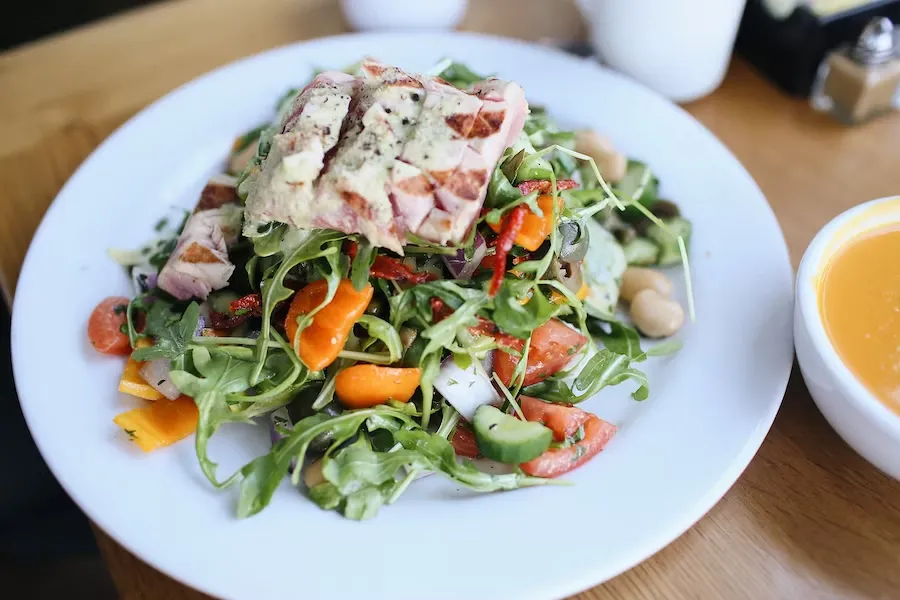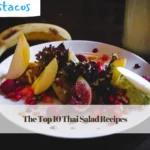1. Cobb Salad: A Symphony of Flavor and Ingenuity
In the vast and varied realm of American salads, few shine as brightly as the Cobb Salad, a true testament to culinary innovation. Born in the 1930s at The Brown Derby, a renowned Los Angeles eatery, this delightful creation emerged from the ingenuity of Robert Cobb. Combining an assortment of kitchen leftovers — hard-boiled eggs, salad greens, chicken breast, avocado, chopped bacon, tomatoes, and Roquefort cheese — Cobb orchestrated a symphony of flavors that would etch its name into culinary history.
Crafting the Culinary Masterpiece
The magic unfolds as these diverse ingredients are meticulously tossed together, guided by a dash of salt, pepper, and a vinaigrette boasting the richness of olive oil, red vinegar, lemon juice, garlic, and Worcestershire sauce. The Cobb Salad owes its enduring popularity to the careful preparation of each ingredient, delivering a harmonious blend of textures, from juicy to crunchy to creamy.
Cobb Salad’s Culinary Legacy
This culinary masterpiece not only pleases the palate but has become a symbol of American culinary prowess. Its inception at The Brown Derby echoes through time, reminding us of the resourcefulness that can turn humble leftovers into a culinary delight. The legacy of the Cobb Salad lives on, celebrated in kitchens and restaurants across the nation.
2. Waldorf Salad: A Timeless Fusion of Flavors
Venturing back to 1896, we encounter the Waldorf Salad, a creation of Oscar Tschirky, the maestro of the dining room at New York’s Waldorf-Astoria Hotel. Initially graced by apples, celery, and mayonnaise, this salad became a sensation. The addition of finely chopped walnuts in 1928 further solidified its identity.

The Evolution of Waldorf Elegance
As time progressed, so did the Waldorf Salad. What began as a simple combination of fruits and mayonnaise has evolved into a culinary icon. The modern Waldorf Salad, adorned with chicken, raisins, or grapes, reflects the ever-changing landscape of American gastronomy.
3. Chinese Chicken Salad: A Fusion of Cultures
Contrary to its name, the Chinese Chicken Salad is an American creation, attributed to Austrian chef Wolfgang Puck or speculated to have emerged in the 1930s. Featuring shredded chicken, lettuce, vegetables, fried noodles, and almonds, the infusion of Chinese-style seasonings like soy, sesame, and ginger elevates its allure.
The Fusion Dance on the Plate
Chinese Chicken Salad not only blends ingredients but also cultures. It stands as a testament to the melting pot that is American cuisine, where diverse influences come together to create something uniquely delicious. The marriage of Asian flavors with American culinary creativity is evident in every forkful.
4. Coleslaw: A Dutch Legacy in American Cuisine
Tracing its origins to the Dutch term “koolsla” (cabbage salad), coleslaw has firmly embedded itself as an American classic. Introduced by Dutch settlers in the 18th century, this side dish unites shredded cabbage with mayonnaise, carrots, and a medley of buttermilk or sour cream, vinegar, sugar, and assorted seasonings.

Regional Variations and Culinary Diversity
Coleslaw’s charm lies not only in its simplicity but also in its adaptability. Regional variations introduce a kaleidoscope of flavors, with some opting for salad dressings, and others adding celery seeds, grated cheese, pineapple, or peppers. The result is a dish that mirrors the diverse tastes of the American palate.
5. Texas Caviar: A Texan Fiesta on the Plate
Contrary to its name, Texas caviar doesn’t boast fish eggs. This Texan delight is a medley of black-eyed peas, garlic, scallions, bell peppers, jalapeños, celery, coriander, parsley, red wine vinegar, vegetable oil, sugar, salt, and pepper.
Flavorful Alchemy and Texan Tradition
Texas Caviar is not just a salad; it’s a celebration of Texan culinary heritage. The alchemy of ingredients, from black-eyed peas to jalapeños, showcases the bold and vibrant flavors that define Texan cuisine. Each bite is a journey through the Lone Star State’s rich culinary tapestry.
6. Chef Salad: A Wholesome Gastronomic Journey
A chef’s salad, a substantial meal in itself, weaves a tapestry of vegetables, hard-boiled eggs, cheese, and meats like ham or turkey. With disputed origins, some link it to the 17th-century salmagundi, while others credit Louis Diat, a chef at the Ritz-Carlton Hotel in New York City, in the 1940s.
Culinary Ambiguity and Gastronomic Excellence
The mystery surrounding the origins of the Chef Salad only adds to its allure. Whether inspired by centuries-old recipes or born out of mid-20th-century culinary innovation, this hearty dish continues to grace tables with a medley of flavors and textures. The Chef Salad stands as a testament to the ever-evolving nature of American gastronomy.
7. Macaroni Salad: A Symphony of Textures
An integral part of Hawaiian plate lunches, macaroni salad is a delightful blend of tanginess and sweetness. Featuring overcooked elbow macaroni pasta dressed with milk-thinned mayonnaise, this dish’s popularity spans from the early 20th century to the Nouvelle Cuisine movement of the 1980s.

Culinary Evolution and Cultural Influence
Macaroni Salad’s journey from a simple recipe in 1962 to a beloved dish in the 1980s reflects the dynamic evolution of American culinary tastes. Whether it be a part of traditional Hawaiian feasts or embraced as part of culinary movements, the Macaroni Salad remains a versatile and beloved classic.
8. Crab Louie: Coastal Delight
Dating back to the early 20th century, Crab Louie is a coastal delicacy featuring Dungeness crab meat, tomatoes, iceberg lettuce, asparagus, hard-boiled eggs, and a signature Louie dressing. Its origins are shrouded in mystery, with tales of its first appearance in a San Francisco restaurant in 1914.
Coastal Splendor and Culinary Intrigue
Crab Louie not only tantalizes the taste buds with fresh crab and crisp vegetables but also invites us into a world of culinary intrigue. Was it really born in 1914, or did it have earlier, hidden incarnations? Regardless, Crab Louie continues to captivate as a delightful coastal indulgence.
9. Frog Eye Salad: A Fusion Extravaganza
Frog Eye Salad, a fusion marvel, combines acini di pepe pasta, egg yolks, and a whipped cream topping. Popular in Utah, this crossover between pasta and fruit salads often incorporates pineapple, shredded coconut, mandarin oranges, or marshmallows.
Fusion Harmony and Regional Delight
Utah’s love affair with Frog Eye Salad is a testament to the unique regional delights that dot the American culinary landscape. The amalgamation of pasta, fruit, and whipped cream creates a dish that transcends categories, offering a sweet and savory symphony on the taste buds.
10. Pittsburgh Salad: Where Tradition Meets Innovation
Originating from Pittsburgh, Pennsylvania, the Pittsburgh Salad puts a twist on tradition. A bed of lettuce adorned with tomatoes or other vegetables, topped with beef steak or grilled chicken, and crowned with crispy french fries, this salad is a celebration of flavors and textures.
Serving Tradition and Culinary Boldness
Pittsburgh Salad doesn’t just defy tradition; it embraces it with a boldness that defines American cuisine. The melding of a classic salad with the heartiness of steak, chicken, and the crunch of french fries showcases the inventive spirit that has come to define the culinary landscape of Pittsburgh.
conclusion
Salads stand as gastronomic monuments, reflecting the diverse and dynamic culinary landscape of America. Each bite tells a story, weaving together the threads of innovation, tradition, and regional flavors into a tapestry that continues to evolve. As these salads grace our tables, they not only satisfy our palates but also serve as a celebration of the rich and varied heritage that defines American gastronomy.
Read Also:- 13 Incredible Burrito Styles You MUST Try





